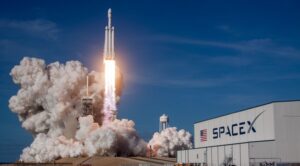Astrobotic won a NASA competition through the Commercial Lunar Payload Services (CLPS) program last year to transport VIPER on its Griffin lunar lander.
“Getting to the moon isn’t just about building a spacecraft, but having a complete mission solution. SpaceX’s Falcon Heavy completes our Griffin Mission 1 solution by providing a proven launch vehicle to carry us on our trajectory to the moon,” Daniel Gillies, director of Griffin Mission 1 at Astrobotic, said in a statement.
Astrobotic declined to disclose the terms of the deal. SpaceX publishes a list price of $90 million on its website for Falcon Heavy, although some government contracts for Falcon Heavy missions have been significantly more expensive. Astrobotic also declined to identify what other launch options it considered for the mission.
VIPER is a NASA mission to investigate permanently shadowed regions of craters at the lunar south pole that may contain deposits of water ice that could serve as resources for future crewed missions. It is designed to operate for 100 days after landing.
NASA originally planned to launch VIPER in 2022, with a mission cost of $250 million. However, NASA postponed the launch to late 2023 to provde more time for work to increase VIPER’s mission life from 14 to 100 days. That, in turn, drove up the cost of VIPER to $433.5 million, NASA disclosed in March.
VIPER is the biggest mission that is part of CLPS, a NASA initiative to purchase payload accommodations on commercial lunar landers. Astrobotic won a $199.5 million task order in June 2020 to deliver VIPER to the lunar surface on its Griffin lander.
Most of the landers flying CLPS missions selected to date will launch on SpaceX. Intuitive Machines, which won CLPS task orders for two lander missions, will launch each on Falcon 9 vehicles late this year and in 2022. Masten Space Systems selected SpaceX to provide launch services for its XL-1 lander mission, which won a CLPS award for a late 2022 mission.
Astrobotic will launch its first CLPS mission, a smaller lunar lander called Peregrine, on the inaugural launch of United Launch Alliance’s Vulcan Centaur currently scheduled for late this year. Firefly Aerospace, which won the most recent CLPS award in January, has not selected a launch provider yet for its Blue Ghost lander, but noted the lander is too large to launch on the company’s own Alpha rocket.
The Astrobotic contract adds to a growing backlog for the Falcon Heavy, which has not flown since the Space Test Program (STP) 2 mission in June 2019. The next Falcon Heavy launch is expected no earlier than July, carrying a classified payload for the U.S. Space Force. Another Falcon Heavy launch for the Space Force is scheduled for late this year.
SpaceX has won NASA contracts for Falcon Heavy, including the launch of the Psyche mission the metallic asteroid of the same name in 2022 and, in February, the first two elements of the lunar Gateway in 2024. Falcon Heavy is also the front-runner for the ongoing competition to launch the Europa Clipper mission after NASA concluded that mission could not launch on the Space Launch System as originally planned.
Gillies, the Astrobotic manager for Griffin Mission 1, previously worked at SpaceX, where he was a mission integrator for the STP-2 Falcon Heavy launch. “Having previously sat on the other side of the table as a former SpaceX mission manager, I am fully aware of SpaceX’s capabilities and processes and am excited to be working with SpaceX on a mission once again,” he said.



